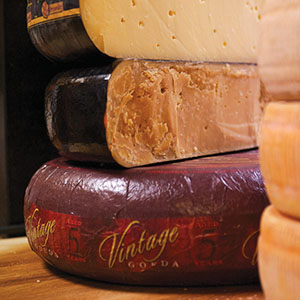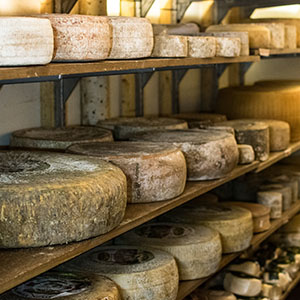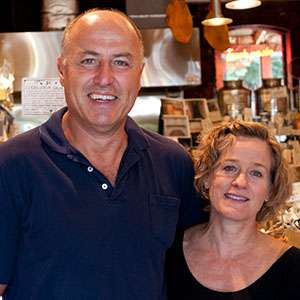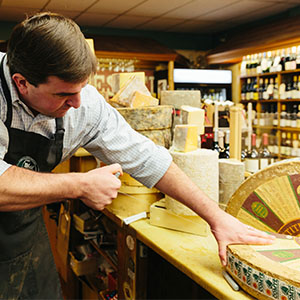In Colonial times in Massachusetts, cheese was not on people’s radar. When they landed in Boston in 1630, the Pilgrims brought with them mainly beans and hardtack.
The region is rich with history-making events; the Revolutionary War started in Lexington and Concord on April 19, 1775, followed by the Siege of Boston, the Battle of Bunker Hill and General Washington taking command of the Continental Army on Cambridge Common. That army also ate beans and hard tack. We had the navy bean, the pea bean and the kidney bean. All of them baked.

During this period, Boston was known for its rich history, not food, and particularly not cheese, which was in scarce supply and only available to those who could afford the high-priced delicacy.
Back then, farmers skimmed off the top curd of their herds’ milk and fed it to the hogs to fatten them up to sell at markets.
Fast forward a few centuries and things have changed. Today, farmers are saving their dairy farms by making cheese, and the farm-to-table movement is prevalent in Boston’s restaurants and shops.
Nowadays people, myself included, want to know where their vegetables, meats and cheeses come from.
At these four Massachusetts cheese shops, not only will you get personalized service, but the staff also will provide visitors with an education on the cheeses’ origin, including farm, country and breed of cow, sheep or goat that contributed milk in the making of the cheese.
The Cheese Shop in Concord

The Cheese Shop is located in an 18th century building in Concord Square. Owner Peter Lovis has been working with cheese in one way or another since he was 15 years old and took a part-time job in a shop in New Jersey. “I was only there a week when the owner handed me the keys saying he was going on vacation and I was in charge,” he says. “After graduating from Union College in 1982, I worked in the wholesale, distribution and import sides of the cheese business.”
While mentioning that he carries 800 different cheeses a year from Italy, France, Spain, Tasmania, the United Kingdom, the Netherlands, Massachusetts and Vermont, Lovis asked if I cared to sample some. Not being one to turn down cheese, I stepped up to the counter. My immediate thought on sampling the L’Amuse Gouda from Dutch affineur Betty Koster was caramel and butterscotch. Next up was the clothbound Cheddar from Jasper Hill Farm, mellow, yet sharp and tangy.
This place has been a cheese shop since 1967, and Lovis is its third owner. Since purchasing it in 2003, he has expanded to 2,000 square feet, adding a deli counter and a kitchen.
According to Lovis, the shop is very low-tech, with 16 employees, five of whom are cheesemongers. Mike is the go-to guy for wine pairings, and what chutneys, jams or crackers go best with different cheeses.
“To be a good cheesemonger you have to be a good listener,” says Lovis. I could see why; I overheard a woman say, “My mother sent me in to get some buttery-tasting cheese. She’s bought it here before but can’t remember the name, just that it was buttery tasting.” After several questions and samplings for texture, color and scent, the employee found the right cheese.
The shop offers a Friday night dinner club, which consists of a four-course takeout meal with wine. Cooked by in-house Chef Justin Kopaz, the menu changes weekly, and reservations must be made by Wednesday.
When I asked Peter what his favorite cheese was, he exclaimed, “That is like asking me to name my favorite mistress. I love all kinds of cheese.”

Formaggio Kitchen in Cambridge
Tim Bucciarelli has been at Formaggio Kitchen in Cambridge for 14 years, and he knows his way around cheese. This isn’t just a cheese shop, although they carry hundreds of varieties; this is a neighborhood go-to place for all the accoutrements that go along with cheese, including house-made tasco ham, crepinettes, chicken livers and artisan breads from Pair de Avignon on Cape Cod. To compliment these delicacies are wines from France.
There are 13 cheesemongers along with 27 regular employees in the Cambridge store, 20 in their shop in Boston’s South End and two in their recently-opened stall at the Essex Street Market on the lower east side of Manhattan.
The small front store was purchased by Ishan and Valerie Gurdal back in 1980. Ishan broke down a wall to an adjacent shop to add the bakery then opened another wall to add the meats, vegetables and flowers section.
The shop supports local farms and businesses. “A lot of our customers are foot traffic,” he says Bucciarelli credits the dedicated neighborhood followings for much of their success.
Depending on the time of year, with holidays being the busiest, the stock consists of between 220 to 300 varieties of cheeses. Talking about the bountiful selection, it was at this point that I started sampling. I found the Bonne Bouche to be a gooey, sweet goat cheese with an ash coating that gave off a lovely tang, The Garrotxa, a goat’s milk cheese from Catalonia, had a full-bodied flavor from months of aging in natural caves. The Mixed Drum was s a blend of raw goat’s and cow’s milk. I loved its nutty, grassy flavor. The triple cream Bayrischer Blauschimmelkase (German blue cheese) is the best I have tasted outside of Germany.
Bucciarelli’s favorite cheese, “A Comté, very versatile, goes with anything.”

When I asked how they store the cheeses, Bucciarelli took me down into the subterranean cellar to a temperature-controlled cave filled with wheels of cheeses. I was in heaven. Bucciarelli explained, “They are stored for anywhere from two days to six months. The longer certain cheeses are stored, the deeper and more fragrant the taste.”
He went on to say, “This is a dying breed of a shop that gives personal service as opposed to a grab-and-go place. We are finding that people, especially young people, want to know where the food they are buying comes from.”

Wasik’s The Cheese Shop
On my visit to Wasik’s Cheese Shop, I eavesdropped on the interactions between at least a dozen customers and staff. Every question, “What wine should I serve with this Camembert?” to “I want a special cheese for a party I’m hosting” to “What cheese goes good with this stout Porter Beer?” was answered knowledgeably and patiently by Carol and her sons Brian and Brad Wasik. The shop has been here since 1979, so it’s no surprise that the Wasiks know their customers and their cheeses. And, being good cheesemongers, they give lots of samples. I should know; I tried a little bit of everything in their cases, and all varieties were delicious and distinct in character.
Brian and Brad grew up working here. After years of working with cheese distributors, their father Stephen opened this tiny, 880-square-foot store in Wellesley Square.
According to Brian, “Today people refer to cheeses as ‘artisan’; little do they know that artisan cheeses have been around for many, many years.”

In their ripening cellar are goat cheeses from the Loire Valley; Comté from the French Alp’s region, English clothbound Cheddar; Saint Agur, a triple cream blue cheese from the Auvergne area of France; aged Swiss Gruyère, a cow’s milk cheese from the Alps; and Cheddar from Bandon, OR. Brian is the affineur of the cellar. He orders the cheeses, determines which ones go into the cellar and checks them every day, turning, poking and hefting, testing their readiness for selling.
On the front counter, there was a crockery bowl full of fresh Stracciatella. The cases are stocked with Bries from Bourgogne that have been rinsed with brandy while aging to give them a deep golden color, and some are washed with champagne. Brian explained, “The cheesemongers in France measure the mold on their Bries carefully, turning them often so it’s evenly layered.”
When I asked Brian what his favorite cheese is, he grinned and said, “It depends on what I’m drinking.”
Jasper Hill Farm

Twenty years ago, brothers Andy and Mateo Kehler took a leap of faith and started a cheesemaking business, Jasper Hill Farm in Greensboro, Vermont’s Northeast Kingdom. They wanted to give back to a town that was struggling, where the young went off to college and, because of lack of industry, didn’t come back.
Since then, the farm has grown in acreage and production. The brothers are bringing together support for agricultural communities with cheese made on Vermont farms.
To say that Kara Chadbourne loves what she does for work is putting it mildly. She is the manager of Jasper Hill Farm’s cheese stand at the Boston Public Market. In talking about the farm’s five varieties of cheeses, her words tumbled out faster than thoughts could drop from her brain to her tongue. Her face took on a glow when I asked her to describe what goes into the making of Jasper Hill Farm’s cheese. “It’s definitely the girls,” she said, “The girls being our 44 Ayrshire cows. Their milk is very rich and pure from the grass and hay they eat.”
The stall has a beautiful selection of cheeses, all of which are from Vermont. Chadbourne explained, “Alex and Mateo are serious about supporting Greensboro and surrounding dairy farms and Vermont, in general. Everything in the stall is made in Vermont.”
They built on the farm seven underground humidity-controlled vaults where they age their cheeses and some from neighboring dairy farms. Inside the vaults is a microbiology lab with a biologist capturing microflora to inoculate the cheeses.
Jasper Hill’s cheeses are named for people and places with a connection to Vermont; their Moses Sleeper, a soft ripe Brie, is named for a Revolutionary War scout; the dense, veiny Bayley Hazen Blue is in homage to the road that Moses Sleeper was killed on defending a strategic blockhouse. When I tasted the Willoughby, a rind-washed cheese named for the Northeast Kingdom’s Lake Willoughby, I got the flavor of peaches and pears. The Alpha Tolman, an Alpine blended buttery cheese, is a nod to an early 20th century Greensboro dairy farmer. The slice I sampled was from a young batch so I got a fruity taste. Allowed to age up to a year, the taste would be of mushrooms and caramelized onions.
Several years ago, Cabot Farms, one of the best known brands of Vermont cheeses, started a collaboration with Jasper Hill to age Cabot’s clothbound Cheddars in Jasper Hill’s vaults. When the cheese arrives, it’s coated with lard and covered with more cheesecloth. Daily brushing with brine gives it a firm rind. It’s known for its pungent nutty aroma and caramel taste.
When I asked Chabourne what her favorite cheese was, without hesitation she said, “The Bayley Hazen Blue. I love it.” Based on that, I went home with a good sized piece of Bayley Hazen Blue and some Alpha Tolman.
Read more about Jasper Hill’s award winning cheeses here.
Shops Info:
CONCORD CHEESE SHOP:
29 Walden St., Concord
978-369-5778
concordcheeseshop.com
FORMAGGIO KITCHEN:
244 Huron Ave., Cambridge
617-354-4750
www.formaggiokitchen.com
WASIK’S, THE CHEESE SHOP:
61 Central St., Wellesley
781-237-0916
www.wasiks.com
JASPER HILL FARM:
Boston Public Market
100 Hanover St., Boston
802-533-2566
www.jasperhillfarm.com



